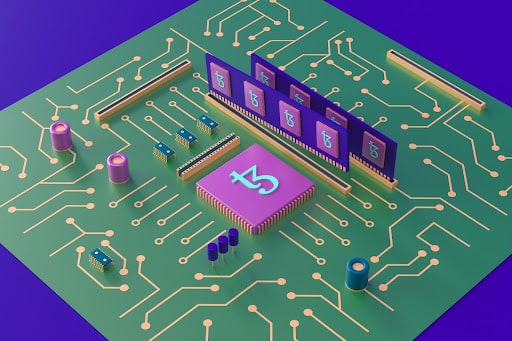The Evolution of Art in the Digital World: NFTs on the Rise
NFTs are unique items that cannot be replaced with anything else. For example, a Bitcoin is fungible, meaning you can exchange it for another Bitcoin and get the same result. The Ethereum blockchain, on the other hand, is used for most non-fungible tokens.
Although cryptocurrencies are intended as a means of payment, only a few firms accept them as a form of payment today. Crypto supporters believe it can be used for a wide range of financial purposes, but it may take some time for the digital currency to gain traction.
The growth of cryptocurrencies has led to the development of world-class trading brokers and platforms such as Binance, Bitcoin upand Coin base. Everyone is giving them a chance to invest in crypto and learn all there is to know about this fascinating new addition to global finance.
Art appreciation through NFT Artworks
Although Ethereum, like Bitcoin and Dogecoin, is a cryptocurrency, the blockchain also enables NFTs, which have additional information that makes them behave differently than, say, an ETH coin. It is worth mentioning that NFTs can be implemented in different ways on different blockchains.
But unlike actual works of art, NFTs are meant to give you something that cannot be copied: ownership of the piece, while the artist retains copyright and reproduction rights. In the digital world, NFTs are one new asset which can be purchased.
You need to convert your money into a digital currency like Bitcoin or Ether to buy an NFT. But from this brief explanation, one can extract very little relevant information about Ether, a property of Ethereum, which markets itself as a “community-driven platform that powers the cryptocurrency ether (ETH) and hundreds of decentralized apps.”
You need a cryptocurrency wallet that accepts Ether (ETH) to buy it. Your account with a website where you can buy or sell cryptocurrencies is different from your wallet.
Where to trade NFTs?
OpenSea, Rarible, SuperRare and Mintable are among the platforms that allow consumers to buy NFTs. Unlike all other platforms, OpenSea is the largest NFT marketplace and has a closer relationship with Etherium than any other. Because a central institution does not control NFTs, actual ownership of these assets can only be achieved through ownership on a public blockchain.
The future of NFTs

The returns for many artists, singers, influencers and others have been significant, with investors paying top dollar to buy NFT copies of digital images, even though it can be difficult for the uninitiated to understand.
Each NFT’s unique design can be used in a variety of ways. It’s a wonderful way digitally represent things such as artwork, music, real estate, etc. NFTs can also be used to disintermediate and connect artists to audiences, as well as for identity management because they are built on blockchains. NFTs have the potential to eliminate middlemen, streamline transactions and open up new markets.
Advantages of NFTs
Cryptocurrencies are suitable for use as a secure medium of exchange in the digital economy due to their fungibility. Cryptocurrencies, like real money, are fungible, meaning they can be exchanged or sold for other cryptocurrencies.
For example, one Bitcoin is always valued the same as another. In all cases, a single unit of Ether is the same as another unit of Ether.
Improving market efficiency
The most obvious benefit of NFTs is their potential to improve market efficiency. Transforming a physical resource into a digital one can help reduce costs, remove intermediaries, improve supply chains and increase security. A perfect example takes place in several parts of the art world.
Artists’ engagement with collectors and fans
A perfect example takes place in several parts of the art world. Artists can increasingly engage directly with their fans due to NFTs, eliminating the need for expensive intermediaries and time-consuming transactions.
Furthermore, the digitization of works of art improves the process of identification, speeds up transactions and reduces expenses. The most obvious benefit of NFTs is their potential to improve market efficiency.
Transforming a physical resource into a digital one can help reduce costs, remove intermediaries, improve supply chains and increase security.
More liquidity, higher prices

Certain assets, such as real estate, art and expensive jewelry, are difficult to divide today. A computerized structure copy is significantly easier to share between several owners than an actual one.
This is an example of a valuable piece of jewelry or a rare bottle of wine. Digitization can significantly expand the market for certain assets through digitization, resulting in more liquidity and higher pricing. On a personal level, it can improve how financial portfolios are built, allowing for more accurate position sizing and diversification.
Safety and security of blockchain technology
In theory, all NFTs on the blockchain have their own records of authenticity and chain of ownership, so they cannot be tampered with or stolen. It is impossible to edit or delete data after it has been added to the chain.
As a result, the scarcity and authenticity of each NFT is preserved, resulting in a level of trust uncommon in many marketplaces. Blockchain technologywhich is a mechanism to store data in a way that cannot be hacked, altered or deleted, is used to produce NFTs.
A blockchain is a distributed record of transactions that is copied and spread across a large number of participants in a peer-to-peer network.
Final thoughts on NFTs: Is it a good investment?
Cryptocurrency investors are maturing. This suggests that while young, male and educated investors continue to buy cryptocurrencies, the gap between them and the general public has narrowed over time. More “traditional” investors became interested and attracted to this asset class as its excitement grew. If investors know the purpose of NFT, it can be a good investment. A better bet for the long-term survival of what an NFT is is to make sure you have something that has utility.


